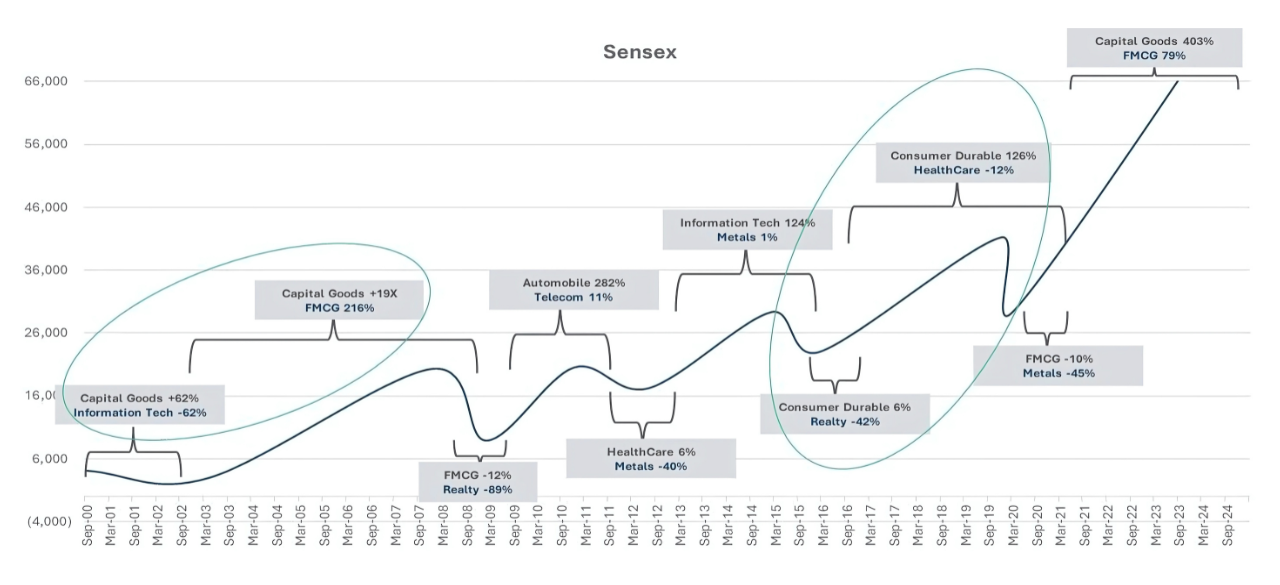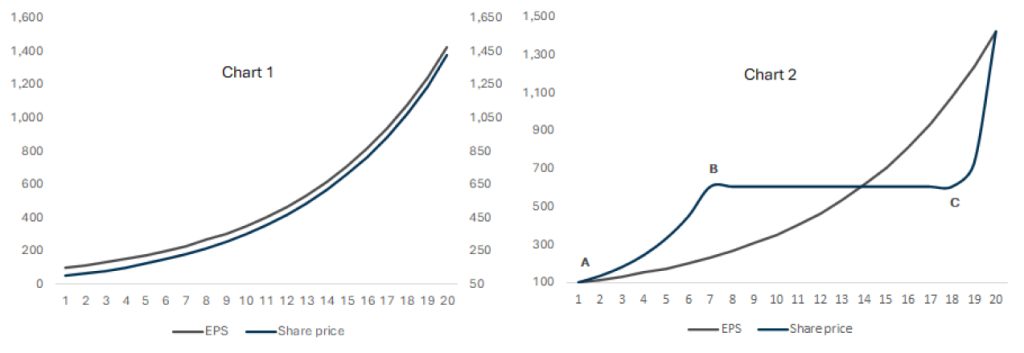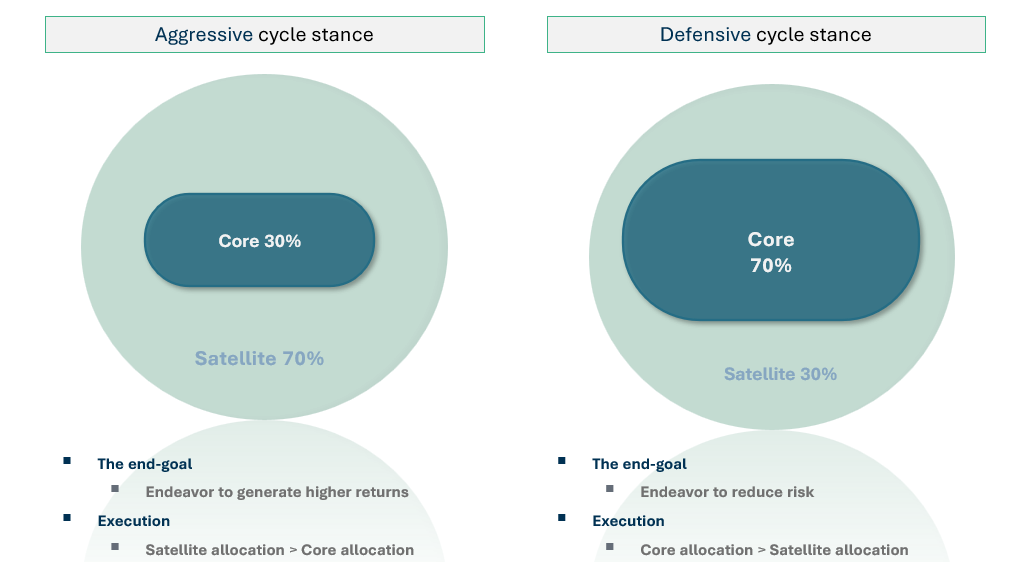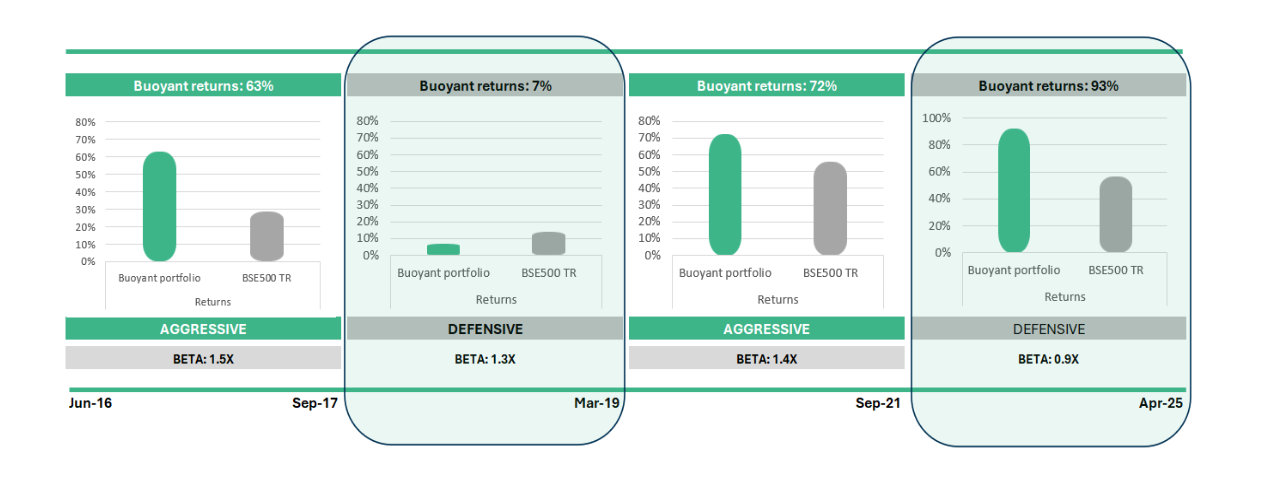Philosophy
April 25, 2023 2025-05-14 12:37Philosophy
Our Philosophy Of Fund Management
Investor perception is often shaped by a linear way of thinking — assuming that investments move steadily upward or downward. But in reality, nothing of significance in the markets follows a straight path. Everything moves in cycles. This cyclical nature is not limited to indices or sectors; individual companies go through their own cycles over time.

Source: Bloomberg, Buoyant Capital analysis.
Past performance is not indicative of future results. The index details are for representational purposes only and are not investment recommendations.
The portfolio manager may or may not have exposure to the sectors or stocks represented in the index. Investing in equities involves risks, including the potential loss of principal, as stock prices can fluctuate based on market conditions and company performance.
Past performance is not indicative of future results. The index details are for representational purposes only and are not investment recommendations.
The portfolio manager may or may not have exposure to the sectors or stocks represented in the index. Investing in equities involves risks, including the potential loss of principal, as stock prices can fluctuate based on market conditions and company performance.
To illustrate this, consider the two charts below. They compare:
(a) the growth of a company’s fundamental value (measured through EPS growth), and
(b) the growth in the company’s share price over time.
(a) the growth of a company’s fundamental value (measured through EPS growth), and
(b) the growth in the company’s share price over time.
The left chart reflects a typical investor’s perception — that a company delivering consistent earnings growth (say, 20% annually) should see its share price rise at a similar rate each year.
The right chart shows how markets behave in reality. Initially, the discovery of a high-quality company drives its stock price up faster than its fundamentals (Point A to B). Eventually, the market realizes it is overpaying for future growth, leading to a prolonged period where the fundamentals keep rising, but the share price remains flat (Point B to C). This sideways phase can last a decade or more.

Source: Bloomberg, Buoyant Capital analysis.
Past performance is not indicative of future results. The index details are for representational purposes only and are not investment recommendations.
The portfolio manager may or may not have exposure to the sectors or stocks represented in the index. Investing in equities involves risks, including the potential loss of principal, as stock prices can fluctuate based on market conditions and company performance.
Past performance is not indicative of future results. The index details are for representational purposes only and are not investment recommendations.
The portfolio manager may or may not have exposure to the sectors or stocks represented in the index. Investing in equities involves risks, including the potential loss of principal, as stock prices can fluctuate based on market conditions and company performance.
Because indices, sectors, and companies all move through cycles, we believe the most effective investment strategy is to invest in alignment with these cycles.
At Buoyant, our fund management philosophy revolves around understanding these sectoral and business cycles deeply. Our goal is to deliver higher risk-adjusted returns over the long term, by adapting our strategy to where we are in the cycle.
We implement this through two complementary approaches:
- An aggressive stance when aiming for higher returns
- A defensive stance when the focus shifts to reducing risk
This involves dynamic allocation between our Core and Satellite portfolios, adjusting weights based on market conditions and opportunities.

Note: The weights are suggestive, and may change based on fund manager’s discretion, based on market conditions.
Executing this strategy requires insight, discipline, and a strong understanding of the forces driving different phases of the cycle.
How We Approach Fund Management
1
Research
Buoyant’s operational structure differs from that of most investment managers in that it consists of three portfolio managers – Sachin, Jigar, and Viral – also the company’s co-founders. Each oversees specific sectors they have tracked over the past two decades. This approach has historically eliminated familiarity bias and is reflected in our returns (see images below for details).
2
Non-model portfolio
Our philosophy is that managed accounts, such as a PMS, should not be operated as a model portfolio. With us, investors are not fully invested on the initial day. This structure enables investors to concentrate on crucial allocation decisions, rather than attempting to time the market.
3
Skin in the game
Buoyant Capital, along with its directors and their family members, co-invests in the fund through the alternative investment framework.
Track Record Since Inception (June 2016)

Source: Bloomberg, Buoyant Capital analysis.
The performance data for the Portfolio Manager and Investment Approach provided above has not been verified by SEBI or any other regulatory authority. Performance data for periods up to 12 months is presented as absolute returns, while data for periods exceeding 12 months is shown as TWRR. The TWRR figures provided above are net of expenses.
Past performance is not indicative of future results and does not guarantee future returns.
The performance data for the Portfolio Manager and Investment Approach provided above has not been verified by SEBI or any other regulatory authority. Performance data for periods up to 12 months is presented as absolute returns, while data for periods exceeding 12 months is shown as TWRR. The TWRR figures provided above are net of expenses.
Past performance is not indicative of future results and does not guarantee future returns.

Source: Bloomberg, Buoyant Capital analysis.
Past performance is not indicative of future results. The index details are for representational purposes only and are not investment recommendations.
The portfolio manager may or may not have exposure to the sectors or stocks represented in the index. Investing in equities involves risks, including the potential loss of principal, as stock prices can fluctuate based on market conditions and company performance.
Past performance is not indicative of future results. The index details are for representational purposes only and are not investment recommendations.
The portfolio manager may or may not have exposure to the sectors or stocks represented in the index. Investing in equities involves risks, including the potential loss of principal, as stock prices can fluctuate based on market conditions and company performance.


